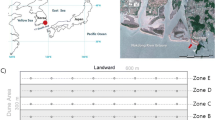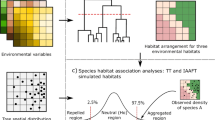Abstract
Topography is rarely considered as an independent goal of restoration. However, topography determines microenvironmental conditions and hence living conditions for species. Restoring topography may therefore be an important first step in ecological restoration. We aimed at establishing the relative importance of topography where coastal dunes destroyed by mining are rebuilt as part of a rehabilitation program. We assessed the response of (1) microclimatic and soil conditions, and (2) woody plant and millipede species richness and density, to location-specific topographic profiles. We enumerated the topographic profile using variables of dune morphology (aspect, elevation, and gradient) as well as relative position on a dune (crest, slope, and valley). Temperature, relative humidity, and light intensity varied with aspect, elevation, gradient, and position. However, regeneration age was a better predictor of soil nutrient availability than these topographic variables. Age also interacted with topographic variables to explain tree canopy density and species richness, as well as millipede species richness. The density of keeled millipedes (forest specialists) was best explained by topographic variables alone. The transient nature of these new-growth coastal dune forests likely masks topography-related effects on communities because age-related succession (increasing structural complexity) drives the establishment and persistence of biological communities, not habitat conditions modulated by topography. However, our study has shown that the microhabitats associated with topographic variability influence specialist species more than generalists.





Similar content being viewed by others
References
Acosta A, Ercole S, Stanisci A, De Patta Pillar V, Blasi C (2007) Coastal vegetation zonation and dune morphology in some Mediterranean ecosystems. J Coast Res 23:1518–1524
Ashwini KM, Sridhar KR (2008) Distribution of pill millipedes (Arthrosphaera) and associated soil fauna in the Western Ghats and west coast of India. Pedosphere 18:749–757
Bennie J, Huntley B, Wiltshire A, Hill MO, Baxter R (2008) Slope, aspect and climate: spatially explicit and implicit models of topographic microclimate in chalk grassland. Ecol Model 216:47–59
Berg MP, Hemerik L (2004) Secondary succession of terrestrial isopod, centipede, and millipede communities in grasslands under restoration. Biol Fertile Soils 40:163–170
Burnett MR, August PV, Brown JH Jr, Killingbeck KT (1998) The influence of geomorphological heterogeneity on biodiversity-I. A patch-scale perspective. Conserv Biol 12:363–370
Chen ZS, Hsieh CF, Jiang FY, Hsieh TH, Sun IF (1997) Relations of soil properties to topography and vegetation in a sub-tropical rain forest in southern Taiwan. Plant Ecol 132:229–241
Clarke KR (1993) Non-parametric multivariate analyses of changes in community structure. Aust J Ecol 18:117–143
da Silva WG, Metzger JP, Bernacci LC, Catharino ELM, Durigan G, Simoes S (2008) Relief influence on tree species richness in secondary forest fragments of Atlantic Forest, SE, Brazil. Acta Botanica Brasilica 22:589–598
David JF, Gillon D (2009) Combined effects of elevated temperatures and reduced leaf litter quality on the life-history parameters of a saprophagous macroarthropod. Glob Change Biol 15:156–165
Dobson AP, Bradshaw AD, Baker AJM (1997) Hopes for the future: restoration ecology and conservation biology. Science 277:515–522
Furley PA, Newey WW (1979) Variations in plant communities with topography over tropical limestone soils. J Biogeogr 6:1–15
Grainger MJ (2012) An evaluation of coastal dune forest rehabilitation through ecological succession. Dissertation, University of Pretoria
Grainger MJ, van Aarde RJ (2012a) Is succession-based management of coastal dune forest restoration valid?. Ecol Restor 30:200–208
Grainger MJ, van Aarde RJ (2012b) The role of canopy gaps in the regeneration of coastal dune forest. Afr J Ecol 51:11–20
Grainger MJ, van Aarde RJ, Wassenaar TD (2011) Landscape composition influences the restoration of subtropical coastal dune forest. Restor Ecol 19:111–120
Greyling MD, van Aarde RJ, Ferreira SM (2001) Seasonal changes in habitat preferences of two closely related millipede species. Afr J Ecol 39:51–58
Kritzinger JJ, van Aarde RJ (1998) The bird communities of rehabilitating coastal dunes at Richards Bay, KwaZulu-Natal. S Afr J Sci 94:71–78
Kubota Y, Murata H, Kikuzawa K (2004) Effects of topographic heterogeneity on tree species richness and stand dynamics in a subtropical forest in Okinawa Island, southern Japan. J Ecol 92:230–240
Larkin D, Vivian-Smith G, Zedler JB (2006) Topographic heterogeneity theory and ecological restoration. In: Falk DA, Palmer MA, Zedler JB (eds) Foundations of restoration ecology. Island Press, Washington, pp 142–164
Laurance WF, Fearnside PM, Laurance SG, Delamonica P, Lovejoy TE, Rankin-de Merona JM, Chambers JQ, Gascon C (1999) Relationship between soils and Amazon forest biomass: a landscape-scale study. For Ecol Manag 118:127–138
Laurance SGW, Laurance WF, Andrade A, Fearnside PM, Harms KE, Vicentini A, Luizao RCC (2010) Influence of soils and topography on Amazonian tree diversity: a landscape-scale study. J Veg Sci 21:96–106
Lawes MJ (1990) The distribution of the samango monkey (Cercopithecus mitis erythrarchus Peters, 1852 and Cercopithecus mitis labiatus I, Geoffrey, 1843) and forest history in southern Africa. J Biogeogr 17:669–680
Loranger-Merciris G, Imbert DB-R, Lavelle P, Ponge JF (2008) Litter N-content influences soil millipede abundance, species richness and feeding preferences in a semi-evergreen dry forest of Guadeloupe (Lesser Antilles). Biol Fertile Soils 45:93–98
MacMahon JA, Holl KD (2001) Ecological restoration: a key to conservation biology’s future. In: Soule ME, Orians GH (eds) Conservation biology: research priorities for the next decade. Island Press, Washington, pp 245–269
Martínez ML, Vásquez G, Sánchez CS (2001) Spatial and temporal variability during primary succession on tropical coastal sand dunes. J Veg Sci 12:361–372
Moir ML, Brennan KEC, Harvey MS (2009) Diversity, endemism and species turnover of millipedes within the south-western Australian global biodiversity hotspot. J Bioegeogr 36:1958–1971
Nichols WF, Killingbeck KT, August PV (1998) The influence of geomorphological heterogeneity on biodiversity II. A landscape perspective. Conserv Biol 12:371–379
Oliviera-Filho AT, Curi N, Vilela EA, Carvalho DA (1998) Effects of canopy gaps, topography, and soil on the distribution of woody species in a central Brazilian deciduous dry forest. Biotropica 30:362–375
Palik BJ, Goebel PC, Kirkman LK, West L (2000) Using landscape hierarchies to guide restoration of disturbed ecosystems. Ecol Appl 10:189–202
Porter K, van Aarde RJ, Wassenaar TD (2007) Millipede identification catalogue. Unpublished Report, University of Pretoria
Rands MRW (2012) Biodiversity conservation: challenges beyond 2010. Science 329:1298–1303
Ritter E, Dalsgaard L, Einhorn KS (2005) Light, temperature and soil moisture regimes following gap formation in a semi-natural beech-dominated forest in Denmark. For Ecol Manag 206:15–33
Scheu S, Schaefer M (1998) Bottom-up control of the soil macrofauna community in a beechwood on limestone: manipulation of food resources. Ecology 79:1573–1585
Tateno R, Takeda H (2003) Forest structure and tree species distribution in relation to topography-mediated heterogeneity of soil nitrogen and light at the forest floor. Ecol Res 18:559–571
van Aarde RJ, Ferreira SM, Kritzinger JJ (1996a) Millipede communities in rehabilitating coastal dune forests in northern KwaZulu-Natal, South Africa. J Zool Lond 238:703–712
van Aarde RJ, Ferreira SM, Kritzinger JJ (1996b) Successional changes in rehabilitating coastal dune communities in northern KwaZulu-Natal, South Africa. Landsc Urban Plan 34:277–286
van Aarde RJ, Ferreira SM, Kritzinger JJ, van Dyk PJ, Vogt M, Wassenaar TD (1996c) An evaluation of habitat rehabilitation on coastal dune forests in Northern KwaZulu-Natal, South Africa. Restor Ecol 4:334–345
van Aarde RJ, Smit AM, Claasens AS (1998) Soil characteristics of rehabilitating and unmined coastal dunes at Richards Bay, KwaZulu-Natal, South Africa. Restor Ecol 6:102–110
van Dyk PJ (1996) The population biology of sweethorn Acacia karroo in rehabilitating coastal dune forests in northern KwaZulu-Natal, South Africa. Dissertation, University of Pretoria, Pretoria, South Africa
van Wyk AE, Smith GF (2001) Floristic and succulent riches in southern Africa: a review of centres of endemism. Umdaus, Pretoria
Wassenaar TD, van Aarde RJ, Pimm SL, Ferreira SM (2005) Community convergence in disturbed subtropical dune forests. Ecology 86:655–666
Weiss SB, Murphy DD (1990) Thermal microenvironments and the restoration of rare butterfly habitat. In: Berger JJ (ed) Environmental restoration: science and strategies for restoring the earth. Island Press, CA, pp 50–60
Weisser PJ, Marques F (1979) Gross vegetation changes in the dune area between Richards bay and the Mfolozi River, 1937–1974. Bothalia 12:711–721
Acknowledgments
The authors declare that they have no conflicts of interest. The study forms part of a larger program conducted by the Conservation Ecology Research Unit (CERU), University of Pretoria and financed by the Department of Trade and Industry and Richards Bay Minerals. The authors also benefited from National Research Foundation grants. We thank members of CERU who assisted with fieldwork and provided helpful comments on earlier versions of this document. The authors declare that the research conducted as part of this study complied with the requirements of South African legislation.
Author information
Authors and Affiliations
Corresponding author
Rights and permissions
About this article
Cite this article
Ott, T., van Aarde, R.J. Coastal dune topography as a determinant of abiotic conditions and biological community restoration in northern KwaZulu-Natal, South Africa. Landscape Ecol Eng 10, 17–28 (2014). https://doi.org/10.1007/s11355-013-0211-1
Received:
Revised:
Accepted:
Published:
Issue Date:
DOI: https://doi.org/10.1007/s11355-013-0211-1




